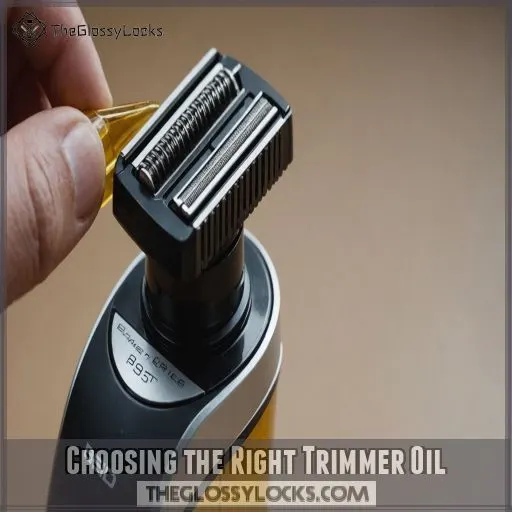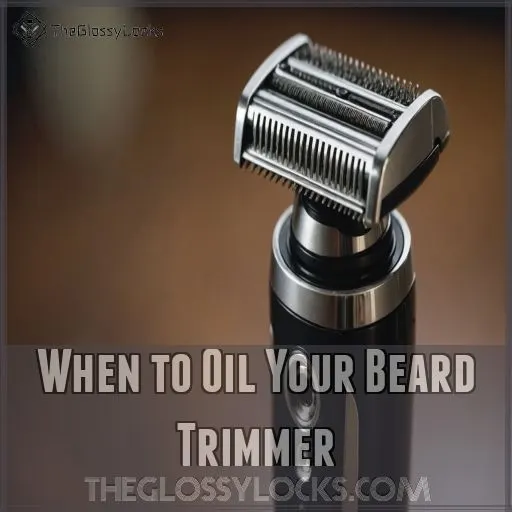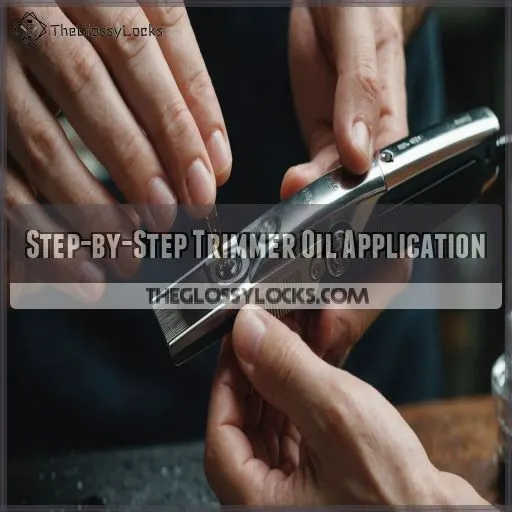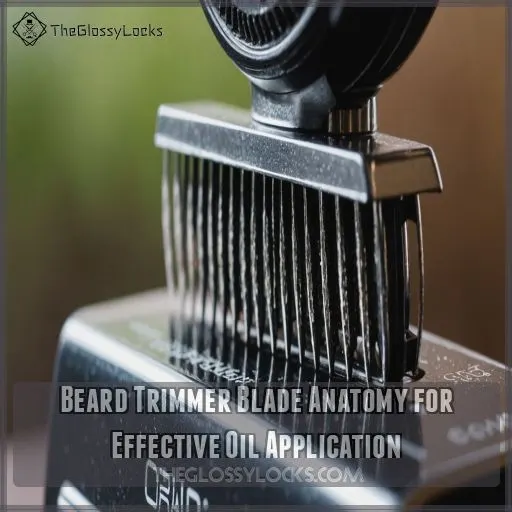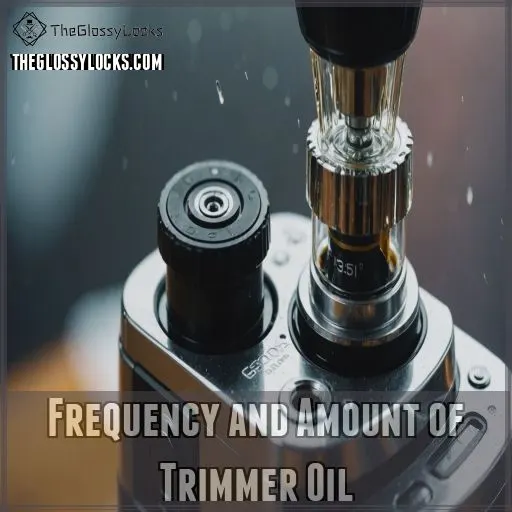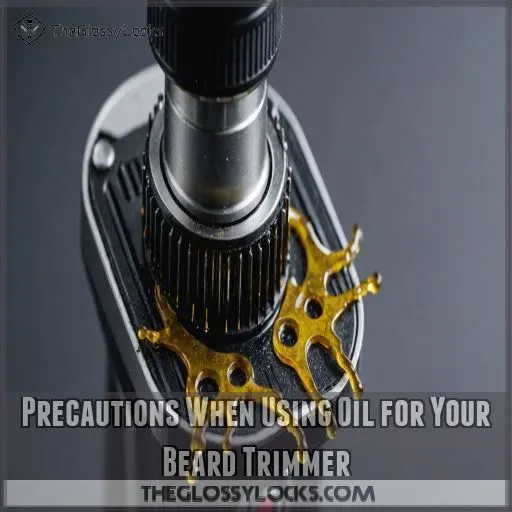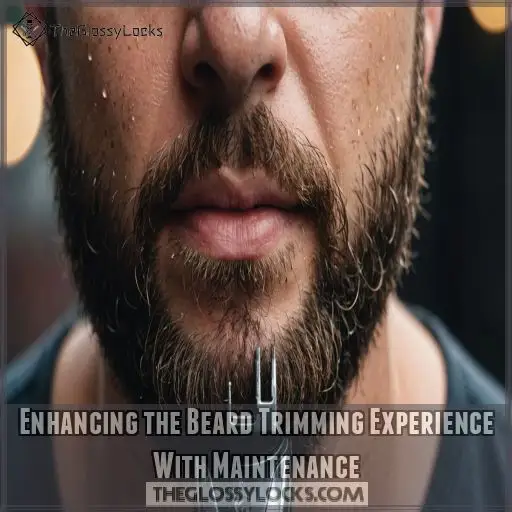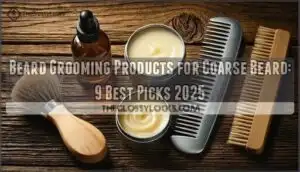This site is supported by our readers. We may earn a commission, at no cost to you, if you purchase through links.
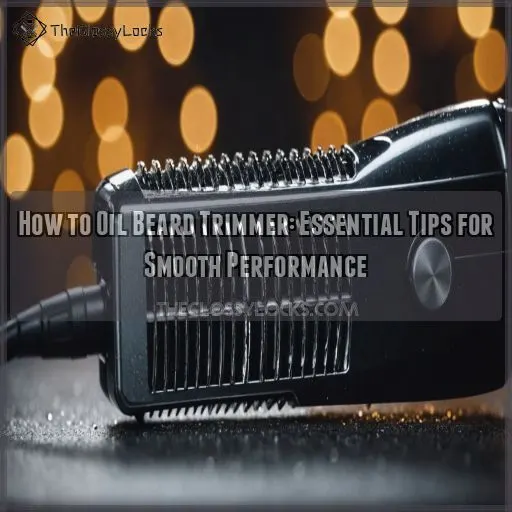 To oil your beard trimmer like a pro, start by unplugging it—safety first, right?
To oil your beard trimmer like a pro, start by unplugging it—safety first, right?
After cleaning the blades with a brush, add a couple of drops of high-quality trimmer oil right on the blade edges.
Give it a quick run for a minute to spread that oil evenly; it’s like a spa day for your trimmer!
Wipe away any extra oil with a soft cloth to avoid mess.
Repeat this routine after each use and before stashing away your trimmer.
Doing so keeps your trimmer sharp and rust-free, making every shave as smooth as possible.
Want smoother cuts? Keep reading!
Table Of Contents
- Key Takeaways
- Choosing the Right Trimmer Oil
- When to Oil Your Beard Trimmer
- Step-by-Step Trimmer Oil Application
- Beard Trimmer Blade Anatomy for Effective Oil Application
- Frequency and Amount of Trimmer Oil
- Precautions When Using Oil for Your Beard Trimmer
- Enhancing the Beard Trimming Experience With Maintenance
- Frequently Asked Questions (FAQs)
- Should I oil my beard trimmer?
- How do you put oil on a beard trimmer?
- What can I use to lubricate my beard trimmer?
- Where to oil beard trimmers?
- Can I use WD-40 instead of clipper oil?
- How do I oil hard-to-reach areas on my trimmer?
- Do cordless trimmers need oiling differently?
- How much oil is too much for my trimmer?
- What type of oil should I use for my trimmer?
- Conclusion
Key Takeaways
- Always unplug your trimmer before oiling—it’s like wearing your safety goggles in science class. Clean those blades, put a few oil drops on, and run it briefly to spread the oil. Your trimmer will thank you by gliding smoothly like a skater on ice.
- Use high-quality clipper oil, not the stuff you use on squeaky door hinges. It’s like picking the right shampoo for your hair—just a small amount ensures your trimmer’s blades aren’t tugging at your beard like a toddler with a new toy.
- Remember, less is more. Too much oil and you’ll have a trimmer that’s slipperier than a wet soap bar. Just a couple of drops will keep those blades running smoothly.
- Give your trimmer a monthly maintenance check with a bit of oil. It’s like flossing for your teeth—preventing rust and ensuring every trim feels as smooth as a jazz saxophone. Keep it sharp, keep it clean, and enjoy stress-free grooming.
Choosing the Right Trimmer Oil
Choosing the right trimmer oil is like picking the perfect sidekick for your beard grooming routine—it helps your trimmer work smoothly and lasts longer.
Don’t skimp on quality; your beard deserves the best lubricant to prevent tugging and promote effortless trimming.
Why High-Quality Oil Matters for Trimmer Longevity
Using high-quality oil for your beard trimmer can help keep it running smoothly, much like using quality beard oils for growth. Why use high-quality oil for your beard trimmer? Premium oils help prevent rust, reduce blade wear, and extend the lifespan of your grooming tool.
Inferior oils can lead to snagging, pulling, and uneven cuts – not the polished look you’re after. Invest in a quality trimmer oil to keep your beard game on point.
Options for Beard Trimmer Oils and Their Uses
Finding the perfect oil for your beard trimmer is like choosing the right sauce for your favorite dish. It enhances everything! Natural oils add smoothness, while synthetic ones offer durability. Consider oil viscosity for consistent application, and explore different brands or DIY oil blends.
- Add a little flair to your grooming.
- Embrace smoother trims.
- Protect your investment.
- Enjoy stress-free maintenance.
Comparing Beard Trimmer Oil With Hair Clipper Oil
Earlier, beard trimmer oils were spotlighted for their diverse uses.
Shifting gears to comparing beard trimmer oil with hair clipper oil, you’ll notice they differ in these aspects:
| Feature | Beard Trimmer Oil | Hair Clipper Oil |
|---|---|---|
| Compatibility | Specifically for beards | General hair purposes |
| Ingredients | Softer on facial hair | Robust, varies widely |
| Price & Availability | Affordable & available | Varies, more options |
Generally, performance is affected by the oil type.
Alternatives to Oil for Beard Trimmer Lubrication
Ever considered using dry lubricants? Try graphite or Teflon for a friction-free experience.
Silicone spray and Vaseline can also work wonders, although they’re not the usual suspects.
With a bit of creativity, you can swap standard oils for these alternatives, keeping your trimmer purring like a kitten without breaking a sweat or your budget.
When to Oil Your Beard Trimmer
Oiling your beard trimmer after each use is essential for keeping it in top shape.
Regular monthly maintenance by oiling the blades will also help your trimmer continue to deliver a smooth, comfortable shave.
Importance of Oiling Trimmers After Use
After trimming, your trusty beard trimmer needs a little TLC to make sure blade longevity and smooth trims for optimal performance. Forgetting is like leaving your car out in the rain—eventually, rust and hair buildup will stall the ride.
- Prevent rust and extend trimmer lifespan.
- Avoid hair pulling for a comfy trim.
- Keep performance excellent.
- Boost cutting efficiency.
Benefits of Oiling Your Beard Trimmer Monthly
Oiling your beard trimmer monthly is like giving it a spa treatment! Think of it as a step for blade longevity and a smooth shave.
Without the friction, your trimmer runs like a dream, extending its lifespan.
It’s the difference between a clean shave and the prickly pear look.
Keep your trimmer oiled for precision and comfort. Use it wisely!
Oiling After Storage: Maintaining Performance
You know how things can get a bit rusty after sitting in storage for too long?
Trimmers, like forgotten tools, can lose their sharpness and shine.
So, before you take your trimmer out of storage, a touch of oil can work wonders.
Use the right oil viscosity to fend off blade rust and boost trimmer lifespan, ensuring great performance.
Step-by-Step Trimmer Oil Application
Oiling your beard trimmer is a simple yet essential step to keep it running smoothly.
Follow our step-by-step guide to properly apply the right amount of oil and make sure your trimmer performs at its best.
Prepare Your Beard Trimmer for Oil Application
Before diving in, unplug your trimmer—you don’t want any surprises!
Disassemble it carefully, treating each part like a puzzle piece.
Time to clean: give the blades a good brush, removing any lurking hair. Let them dry, avoiding mishaps.
Locating the Trimmer Blades and Applying Oil
You’ve got your trimmer in hand; now, find the blades where the action happens.
Gently squeeze a couple of drops of oil along the blade’s edges—this baby needs lubrication like a car needs gas. Choose a high-quality oil type for best results.
Hold the trimmer upright, letting gravity work its magic. Remember, too much oil’s a slippery slope!
Effective Distribution of Oil on Trimmer Blades
Oil your trimmer blades effectively to avoid pulling and snagging, using these blade lubrication tips:
- Steady Hold: Keep a firm grip, like wrangling a mischievous raccoon.
- Drop Technique: Gently apply oil drops to the blade tips.
- Smooth Glide: Activate the trimmer, ensuring the oil evenly coats.
- Extra Care: Utilize a soft cloth for excess oil, avoiding drips.
After-Oiling Precautions to Keep Your Trimmer Running
Once you’ve applied the oil, be sure to turn on the trimmer and let it run for a minute or two.
This helps distribute the lubricant evenly across the blades.
Next, wipe down the exterior with a soft cloth to remove any excess oil.
Store your trimmer properly in a protective case to keep it in tip-top shape between uses.
Beard Trimmer Blade Anatomy for Effective Oil Application
Understanding your trimmer’s blade anatomy is like knowing your dog’s favorite scratch spot—it makes all the difference for smooth, snag-free results.
You’ll learn exactly where to apply oil to keep your trimmer sharp and your beard looking its best.
Distributing Oil for Blade Health
To keep your trimmer running smoothly, think of it as a machine that needs some TLC.
Dab a couple of oil drops on the moving parts, then switch it on for a few seconds.
This helps the oil spread across the blades, coating them evenly.
It’s like giving your trimmer a spa day, promoting smooth operation and longer blade life!
Target Areas to Ensure Blade Smoothness and Hygiene
Understanding blade anatomy is like knowing a car’s nuts and bolts—you’ve got to hit the sweet spots!
Focus on blade edges, teeth, gaps, base, and sides.
A little oil does wonders, turning your trimmer into a well-oiled machine.
Frequency and Amount of Trimmer Oil
Using the right amount of oil at the right time is important for keeping your beard trimmer in good shape.
Discover the ideal oil quantities and application frequency to make sure you get a smooth, effortless trim every time.
Measuring Oil Amount: Correct Quantities and Precision
Eyeballing those oil drops might feel like cooking without measuring cups—tempting but risky. Too much oil leaves a slippery mess, while too little makes those blades complain like a rusty gate. Use tiny oil drop sizes as your guide. Invest in a measuring tool if you fancy precision.
Keep consistency: oil type impacts blade performance, so stick to a quality choice.
Application Timing and Quantity Tips for a Trim
You’ve got the hang of measuring oil, now let’s talk timing.
Oil your trimmer after every 2-3 uses.
It’s like giving it a spa day!
Keep each trim smooth by using just a couple of drops.
Whether you’re maintaining a short stubble or a magnificent mane, oil frequency can prevent blade wear.
Store with care, and you’ll maintain blade longevity.
Precautions When Using Oil for Your Beard Trimmer
When oiling your beard trimmer, don’t go overboard—it’s not a pancake that needs drenching!
Use just the right amount of oil to keep the blades running smoothly, or you might end up with a slippery mess or dull blades.
Important Oil Use Instructions
When oiling your beard trimmer, be mindful of the instructions.
Stick to the recommended oil type and quantity – too little won’t do the job, while too much could gum up the works.
Store the oil properly to maintain its integrity.
And never mix different oils or reuse old batches – that’s a recipe for disaster.
Safety first, my friend!
Combining Oils or Reusing for Various Uses
Now that you’re familiar with oil use, let’s talk about combining oils.
While oil blending might sound like a mad scientist’s experiment, it’s more about practicality.
Multi-purpose oil or a DIY oil mix can work wonders.
Don’t go overboard!
Reused oil or recycled oil isn’t always the best call for your trusty trimmer— aim for effectiveness and safety.
Cross-Reference Using Correct Brands or Volumes
Steering through the realm of beard trimmer oils is like choosing the right tool for the job.
Stick with brand recommendations, making certain the correct oil type graces your blades.
A trusty oil volume guide helps avoid slippery mistakes.
Think of oil as grooming’s unsung hero—size matters, quantity per use is key, and volume comparison ensures precision and effective trimming.
Taking Cautions With Low and Over-Dosing Beard Oil
Balancing trimmer oil might feel like walking a tightrope. Oil underuse effects? Suggestions for disaster! Don’t risk over-oiling risks either—trimming ain’t a slip ’n slide.
Attain perfect oil balance by noticing these signs of excess or recognizing insufficiency:
- Gunky blades.
- Shaving mishaps.
- Feeling like a walrus in the rain.
- Excess sparkles on the skin, or signs of excess sparkles.
Emergency Uses That Use Little Amount
Running low on oil? Don’t stress! In a pinch, small oil amounts can keep your trimmer from whining like a hungry cat. Just dab a tiny bit of oil on the blades for a quick maintenance trick, like lubricating your razor.
Here’s a handy table for urgent lubrication hacks:
| Situation | Oil Needed | Action |
|---|---|---|
| Minor squeaks | 1 drop | Dab lightly |
| Slight pulling | 2 drops | Even application |
| Unexpected trim | 3 drops | Run briefly |
| Pre-storage checks | Small dab | Minimal oil usage |
These last-minute fixes can be lifesavers!
Enhancing the Beard Trimming Experience With Maintenance
You’ve mastered the art of oiling your beard trimmer, now let’s tweak your maintenance routine for that great grooming experience. Think of your trimmer as a trusty sidekick—it needs some care to do its best work. Here’s how:
- Kit Up: Have cleaning tools like brushes and soft cloths ready. They’ll keep your trimmer blade care on point and your trimming seamless for smooth, clean trims.
- Store Smartly: Keep your trimmer in a dry, secure spot. This isn’t fine china, but don’t just toss it in a drawer!
- Love Your Blades: Regularly check and replace worn-out blades. Treat your trimmer well, and it won’t let you down. Remember, happy blades equal stress-free trims!
Frequently Asked Questions (FAQs)
Should I oil my beard trimmer?
Absolutely, you should oil your beard trimmer!
It’s like giving your trimmer a spa day.
It prevents rust, hair buildup, and keeps the blades moving smoothly.
No one wants a snagged beard—it’s painful and annoying!
How do you put oil on a beard trimmer?
Pop a couple of oil drops on your trimmer’s blades, power it up, and let gravity do its thing with the blades facing down.
This helps the oil spread evenly.
You’ll keep the gears humming smoothly, avoiding snags!
What can I use to lubricate my beard trimmer?
Use high-quality hair clipper oil to keep your beard trimmer running smoothly.
Water-based lubricants might seem tempting, but they don’t cut it.
Just like your car needs oil, so does your trimmer for peak performance!
Where to oil beard trimmers?
To oil your beard trimmer, simply apply 1-2 drops of clipper oil directly onto the blades.
Then, turn on the trimmer and hold it with the blades facing downward to distribute the oil evenly.
It’s that easy!
Can I use WD-40 instead of clipper oil?
Stick with clipper oil instead of reaching for WD-40.
It’s the trusty sidekick your trimmer needs for smooth operation.
WD-40’s more a jack-of-all-trades; it might gunk up the works in your precious trimmer.
How do I oil hard-to-reach areas on my trimmer?
Sometimes, those tricky spots on your trimmer feel as elusive as a cat on wash day!
Dab a cotton swab with clipper oil and gently maneuver it into the crevices,
keeping your trimmer running smoothly and purr-free.
Do cordless trimmers need oiling differently?
Cordless trimmers need oiling just like regular ones.
Oil keeps blades dancing smoothly!
Use a few drops monthly to prevent rust and snagging.
It’s like a spa day for your trimmer—pamper it and enjoy seamless grooming.
How much oil is too much for my trimmer?
You don’t want to drown your trimmer in oil – a few drops are all it needs.
Too much can gum up the works and cause more problems than it solves.
Just a light coating will keep it running smoothly.
What type of oil should I use for my trimmer?
Think of oil as your trimmer’s best friend.
Use hair clipper oil, designed to keep blades whisper-smooth and rust-free.
Avoid motor oils—they’re like inviting a bull to a china shop!
Keep things silky and efficient.
Conclusion
Did you know a well-oiled beard trimmer can last up to 50% longer than one that’s neglected for optimal effectiveness??
Whether you’re a beginner or a pro, learning how to oil a beard trimmer is really important for a smooth experience.
With these easy tips, you’ll keep your trimmer performing at its best.
Don’t skip the oil—your beard will thank you!
Keep those blades sharp and running smoothly, and transform trimming into the ultimate self-care ritual.
Happy trimming!

